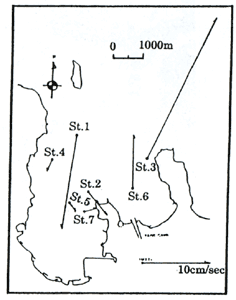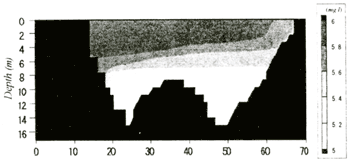|
RESULTS AND DISCUSSION
Figures 3 and 4 show the observed and computed tidal residual flow of the surface
layer. The results of computed tidal residual current showed flows from the north to the south in the
northwestern part of the bay entrance. Also, computed results has good agreement with the results of field
experiment conducted in 1983 (Sasaki and Inoue, 1984) and August 1998 (Kagawa Pref., unpubl.). Westward
current is predominant on the flood tide; on the other hand, eastward current is predominant on the ebb
tide in and around the Bisan-Seto area. The current speed in the area at the mouth of bay is 15-20 cm/s
much larger than near the inner part of bay. Particularly, northward current less than 10 cm/s appear
at-offshore area. Figures 5-8 show the results (August, 2000) of the distribution of DO from field experiment
and computed by numerical model. These results were taken into the DO consumption rate by fish and sediment
at each area in Sido bay. The comparison shows it is necessary to calculate the distribution of DO taking
into the changes in DO consumption rate at each area in a semi-enclosed bay. Figures 9 (at Stn. 4) and
10 show the computed vertical profile of DO ( X-X section, Fig.2). The lowest
values of DO occurred at lower layers between 8 m depth and the bottom. The concentration is over 3.0
ml/l all over the bay and this condition is not bat for fish in an aquaculture grounds. Also, the results
have good agreement with field experiments.
 Figure 3. Observed tidal residual current (surface)
Figure 4. Computed tidal residual current (0-1.5m)
Figure 5. Observed distribution of DO (surface layer)
Figure 6. Observed distribution of DO (lower layer)
Figure 7. Computed distribution of DO (0-1.5m)
Figure 8. Computed distribution of DO (6.5-9.5 m)
Figure 9. Vertical profiles of DO (Stn. 4)
| (Enlarge: 44KB) |
 |
Figure 10. Vertical Distributions of DO (X-X' section)
Figure 11 depicts the velocity field of the surface layer. The computed flow fields are verified by results of field experiment conducted in 1998 (Kagawa Pref., unpubl.). Westward current is predominant on the flood tide; on the other hand, eastward current is predominant on the ebb tide around the Bisan-Seto area. The current speed in the area among the islands is 1.0- 1.5 m/s much larger than near the shore area. Particularly, northward current less than 0.1 m/s appears between Koteshima Island and Teshima Island. We hear from fishermen working and fishing in the area around the Koteshima Island, Teshima Island, Hiroshima Island and Takamishima Island is one of good fishing ground in Bisan-Seto area. The area between Koteshima Island and Teshima Island is considered for main spawning ground.
Figure 11. Computed flow field (depth:0-6 m)
Figure 12 depicts computed trajectories of 400 particles supposed to eggs/larvae during 30 days from the spawning ground. From the results of numerical simulation, about 65% particles are transported toward the shelf region area shallower than 10 m around the four islands. It is suggested from this results, that region would be become a good habitats or nursery grounds for marine resources. It is further necessary to look at how the seasonal wind condition affect on the recruitment in the future.
Figure 12. Computed trajectories of 4,000 particles for 30 days after they
were released from spawning ground where locate the near shore of islands (heard from fishermen who
work in the Bisan-Seto area)
CONCLUSIONS
A numerical model of distributions of DO in an aquaculture grounds has been made. The model was applied to the aquaculture grounds in a semi-enclosed bay that utilizes wave energy for water exchange by itself. Tidal current coming from the north and south generally created a recirculating flow pattern influenced by geographic effect at mouth of the bay. About 60% of the whole bay respiration is due to organisms and chemicals suspended in the water, about 25% is due to the fish in the aquaculture cage, and 15% is due to the sediment. A useful evaluation method to estimate the DO distribution of aquaculture grounds was proposed by using numerical model taking the effect of oxygen consumption rate at each area in semi-enclosed bay into consideration. Also, this study has revealed that transportation of fish eggs and larvae from spawning ground to the nursery ground in and around the Bisan-Seto by using numerical simulation model. Then, it is necessary to take the system for creating fishery ground and to estimate the carrying capacity of aquaculture grounds. It is the most important to do continuous field experiment and that results are applied to numerical simulation model again and again to evaluate of changes marine environment.
ACKNOWLEDGEMENTS
We would like to express sincere thanks to Dr. M. Fujihara, Prof., Faculty of Agriculture, Ehime University; T. Hamagaki, Chief, Marine Environment Research Station, Kagawa University; Mr. T. Yamada, Kagawa Prefectural Fishery Research Institute; Mr. I. Asai, Japan Environment Research Co., LTD.; Mr. T. Hoshino, K. Hisamura, A. Suenaga and K. Kimigawa, Kuroshio Co., LTD., for their assistance and guidance in this study.
REFERENCES
Fujihara, M., Y. Suenaga, H. Nakata, T. Nagasawa and H. Yamada. 1997. Numerical Simulation on the Transport of Brown Sole Eggs and Larvae Using an Euler-Lagrangian Method (in Japanese with English abstract). Fisheries Engineering, 34(2):147-154.
Nakata, H., Y. Suenaga and M. Fujihara. 1999. Wind-induced drift of brown sole eggs and larvae in the shelf region near Sado Strait in relation to the recruitment mechanism. In the Bulletin of Tohoku National Fisheries Research Institute, No.62:51-60.
Suenaga, Y., H. Nakata, M. Fujihara and T. Nagasawa. 1996. Numerical Simulation of the Wind Effect on the Transport of Brown Sole Eggs and Larvae in and around the Sado Strait (in Japanese with English abstract). Fisheries Engineering, 32(3):219-228.
Suenaga, Y., M. Fujihara, T. Sasaki and K. Masuda K. 1999. Development of Evaluation Method for Constructing Aquaculture Habitats. In Recent Advances Marine Science and Technology 98, pp.93-99.
Suenaga, Y., H. Nakata, M. Fujihara and T. Nagasawa. 1996. Numerical Simulation of the Wind Effect on the Transport of Brown Sole Eggs and Larvae in and around the Sado Strait (in Japanese with English abstract). Fisheries Engineering, 32(3):219-228.
Suenaga, Y., M. Fujihara, T. Sasaki and K. Masuda K. 1999. Development of Evaluation Method for Constructing Aquaculture Habitats. In Recent Advances Marine Science and Technology 98, pp.93-99.
|